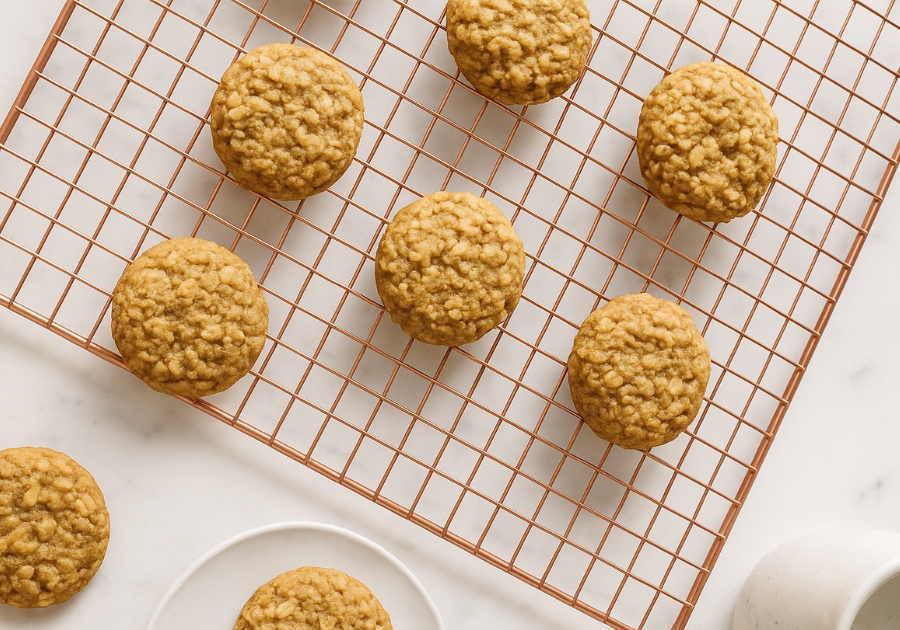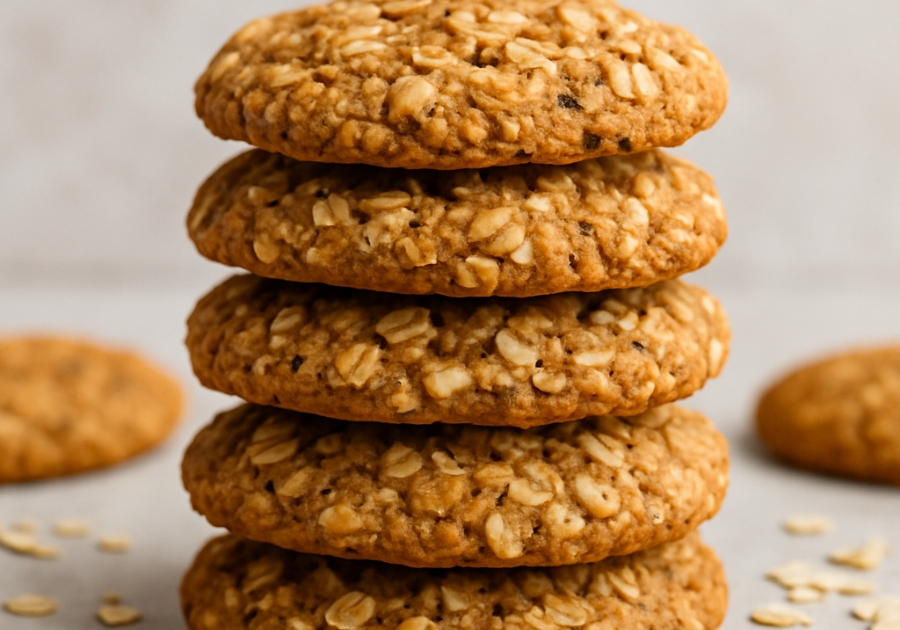Healthy oatmeal cookies aren’t just a better snack — they’re a reminder that comfort food and clean eating can go hand in hand.
I’m Lucas, founder of Cookies Basics, where cookie lovers and curious bakers rediscover the joy of homemade treats. My love for baking started in my childhood kitchen, mixing dough alongside my mom. The flour-covered counters, the smell of vanilla, the warmth of shared laughter — those memories taught me that baking isn’t just about food. It’s about connection.
Cookies Basics was born from that same belief — that homemade cookies can still be comforting while being nourishing. That’s why I began experimenting with wholesome ingredients, leading to one of my most popular recipes: healthy oatmeal cookies.
In this guide, I’ll walk you through what makes these cookies healthy, how to choose the right oats, tips to avoid common baking mistakes, and delicious variations for every lifestyle.
Table of Contents
Table of Contents
The Rise of Healthy Oatmeal Cookies
Why oatmeal cookies became a health trend
In a world where sugary snacks dominate grocery shelves, healthy oatmeal cookies have become a welcomed shift. People aren’t just looking for sweets anymore — they’re looking for better ingredients. Oats, being high in fiber and heart-friendly, offer a base that makes cookies feel less like a cheat and more like a choice.
Unlike processed treats packed with refined sugar and mystery additives, healthy oatmeal cookies combine nutrition and comfort. Whether made with honey, banana, or maple syrup instead of white sugar, these cookies prove you don’t need to sacrifice flavor to eat smart.
As health-conscious habits grow, so does the love for simple, whole food recipes. That’s why more home bakers are turning to oatmeal — it’s familiar, filling, and versatile.
How they compare to traditional cookies
Let’s face it: a classic chocolate chip cookie tastes great, but it often leaves us with a sugar crash. On the other hand, healthy oatmeal cookies offer slow-digesting carbs and sustained energy. While traditional cookies rely heavily on butter and white flour, oatmeal versions invite ingredients like almond flour, coconut oil, or even mashed fruit to the table.
Here’s a quick comparison:
| Feature | Traditional Cookies | Healthy Oatmeal Cookies |
|---|---|---|
| Flour | Refined white flour | Whole wheat or oat flour |
| Sweetener | White sugar | Honey, maple syrup, or banana |
| Fat | Butter | Coconut oil or nut butter |
| Fiber | Low | High (from oats) |
| Energy Crash | Likely | Unlikely |
As more families embrace mindful eating, healthy oatmeal cookies are becoming a go-to snack — especially for parents, athletes, and anyone craving a sweet bite without the guilt.
What Makes Oatmeal Cookies Healthy?
Nutritional breakdown of oats
At the heart of all healthy oatmeal cookies is one star ingredient — oats. Unlike refined flour, oats bring fiber, protein, and essential minerals to every bite. They help regulate blood sugar, support digestion, and keep you feeling fuller longer.
One cup of oats includes:
- 10g of protein
- 8g of dietary fiber
- Rich amounts of iron, magnesium, and zinc
This makes oats a powerhouse for baking — especially when you’re aiming for healthy oatmeal cookies that feel as good as they taste.
Healthy ingredient swaps that work wonders
Traditional cookie recipes often call for sugar, butter, and white flour. But when you’re baking healthy oatmeal cookies, there are easy swaps that boost the nutrition without sacrificing taste.
Here are a few ideas:
| Swap This | For This |
|---|---|
| White sugar | Mashed banana or honey |
| Butter | Coconut oil or avocado |
| White flour | Oat flour or almond flour |
| Chocolate chips | Dark chocolate or raisins |
These swaps not only reduce the processed ingredients in your cookies but also add natural flavors and textures. That’s what makes healthy oatmeal cookies a smarter alternative — they’re real food, not just dessert.
Choosing the Right Oats for Your Cookies
Old-fashioned vs quick oats: What’s best?
When it comes to baking healthy oatmeal cookies, the type of oats you use really matters. Old-fashioned oats, also known as rolled oats, are the gold standard. They hold their shape during baking and create that signature chewy texture people love in a wholesome cookie.
Quick oats, on the other hand, are finer and cook faster. While they work in a pinch, they can make your cookies too soft or even mushy. For structure, chew, and a rustic bite, stick with old-fashioned oats.
The texture of your healthy oatmeal cookies can make or break the experience — and choosing the right oats is step one.
Can I use porridge oats in oatmeal cookies?
Yes, but with a heads-up. Porridge oats are usually finely milled and may soak up more moisture than rolled oats. If you’re using them in healthy oatmeal cookies, expect a softer texture. You may also need to slightly reduce your liquid or add a touch more flour.
Still, porridge oats can work if you’re aiming for a smoother, more cake-like cookie. Just remember, the more processed the oat, the less texture your cookie will have. Always consider what kind of cookie experience you’re after — chewy, soft, or hearty.
How to Bake Healthy Oatmeal Cookies
Step-by-step recipe with calorie counts
Baking healthy oatmeal cookies doesn’t need to be complicated. With a few clean ingredients and one bowl, you’ll have a batch ready in under 30 minutes. Here’s a simple base recipe to start with:
Ingredients:
- 1 cup old-fashioned oats
- ½ cup oat flour
- 1 ripe banana (mashed)
- ¼ cup honey or maple syrup
- ¼ cup coconut oil (melted)
- 1 tsp vanilla extract
- ½ tsp cinnamon
- Pinch of salt
- Optional: dark chocolate chips or raisins
Instructions:
- Preheat your oven to 350°F (175°C).
- In a bowl, mix oats, oat flour, cinnamon, and salt.
- Stir in mashed banana, honey, coconut oil, and vanilla.
- Fold in add-ins like dark chocolate or nuts.
- Drop spoonfuls onto a lined baking sheet.
- Bake for 12–14 minutes, until golden at the edges.
Each cookie comes in around 90–110 calories, depending on the mix-ins. That’s a great number for something sweet, chewy, and nutrient-rich.
Tips to keep them moist and chewy
Dry cookies happen when there’s too much flour or not enough fat. For consistently moist healthy oatmeal cookies, here’s what works:
- Use ripe bananas or applesauce for natural moisture.
- Don’t overbake — pull them out when they’re just set.
- Let them cool on the pan for 5 minutes to finish baking gently.
- Mix gently. Overmixing toughens the dough.
When done right, healthy oatmeal cookies taste just as indulgent as traditional ones — without the sugar crash.
How to Bake Healthy Oatmeal Cookies
Step-by-step recipe with calorie counts
Baking healthy oatmeal cookies doesn’t need to be complicated. With a few clean ingredients and one bowl, you’ll have a batch ready in under 30 minutes. Here’s a simple base recipe to start with:
Ingredients:
- 1 cup old-fashioned oats
- ½ cup oat flour
- 1 ripe banana (mashed)
- ¼ cup honey or maple syrup
- ¼ cup coconut oil (melted)
- 1 tsp vanilla extract
- ½ tsp cinnamon
- Pinch of salt
- Optional: dark chocolate chips or raisins
Instructions:
- Preheat your oven to 350°F (175°C).
- In a bowl, mix oats, oat flour, cinnamon, and salt.
- Stir in mashed banana, honey, coconut oil, and vanilla.
- Fold in add-ins like dark chocolate or nuts.
- Drop spoonfuls onto a lined baking sheet.
- Bake for 12–14 minutes, until golden at the edges.
Each cookie comes in around 90–110 calories, depending on the mix-ins. That’s a great number for something sweet, chewy, and nutrient-rich.
Tips to keep them moist and chewy
Dry cookies happen when there’s too much flour or not enough fat. For consistently moist healthy oatmeal cookies, here’s what works:
- Use ripe bananas or applesauce for natural moisture.
- Don’t overbake — pull them out when they’re just set.
- Let them cool on the pan for 5 minutes to finish baking gently.
- Mix gently. Overmixing toughens the dough.
When done right, healthy oatmeal cookies taste just as indulgent as traditional ones — without the sugar crash.
Print
Healthy Oatmeal Cookies – The Best Guilt-Free Treats (2025)
- Total Time: 22 minutes
- Yield: 12 cookies 1x
Description
Chewy, naturally sweetened healthy oatmeal cookies made with oats, banana, and almond butter. Perfect for clean eating, snacking, or adding to lunchboxes.
Ingredients
- 1 cup old-fashioned oats
- ½ cup oat flour
- 1 ripe banana (mashed)
- ¼ cup honey or maple syrup
- ¼ cup coconut oil (melted)
- 1 tsp vanilla extract
- ½ tsp cinnamon
- Pinch of salt
- Optional: dark chocolate chips or raisins
Instructions
-
Preheat oven to 350°F (175°C) and line a baking sheet with parchment paper.
-
In a mixing bowl, mash banana and combine with almond butter and maple syrup.
-
Add oats, cinnamon, and salt. Mix until fully incorporated.
-
Stir in chocolate chips or raisins, if using.
-
Scoop dough using a tablespoon and drop onto prepared baking sheet. Flatten slightly.
-
Bake for 10–12 minutes, or until edges are golden.
-
Cool on a wire rack before serving.
Notes
-
For crunchier cookies, bake 1–2 minutes longer.
-
Store in an airtight container for 3–4 days or freeze up to 3 months.
-
Swap almond butter for sunflower seed butter to make nut-free.
- Prep Time: 10 minutes
- Cook Time: 12 minutes
- Category: Snacks, Dessert
- Method: Baking
- Cuisine: American
Nutrition
- Calories: ~120
- Sugar: 6g
- Fat: 5g
- Carbohydrates: 16g
- Fiber: 2g
- Protein: 3g
Gluten-Free, Dairy-Free, and Vegan Variations
How to Make Healthy Oatmeal Cookies Allergen-Friendly
If you’re sensitive to gluten, dairy, or prefer a plant-based diet, there’s good news: healthy oatmeal cookies are incredibly adaptable. These cookies can easily be tailored to suit a variety of dietary needs—without losing their flavor or texture.
Let’s say goodbye to bland “free-from” baked goods. With the right swaps, your healthy oatmeal cookies can be just as chewy, satisfying, and full of goodness.
Gluten-Free Options
To make gluten-free healthy oatmeal cookies, start by using certified gluten-free oats. Regular oats often come into contact with wheat during processing, so it’s important to double-check the label.
Instead of traditional flour, opt for:
- Almond flour (adds protein and a nutty flavor)
- Oat flour (you can make it by grinding oats in a blender)
- Coconut flour (be cautious—it absorbs more liquid)
Dairy-Free Cookie Swaps
Ditching dairy doesn’t mean losing that soft, rich cookie texture. For butter replacements in healthy oatmeal cookies, consider:
- Coconut oil (adds subtle flavor)
- Vegan butter (look for one with no hydrogenated oils)
- Mashed avocado (for extra nutrients and creamy consistency)
Instead of milk, try almond, oat, or soy milk—whichever suits your taste buds and dietary goals. These swaps make your healthy oatmeal cookies not just dairy-free, but also even more nutritious.
Egg-Free & Vegan Alternatives
Going egg-free is simple with these great plant-based binding agents:
- Flax egg: Mix 1 tbsp ground flaxseed + 3 tbsp water, let it sit 10 mins
- Chia egg: Similar to flax, but with chia seeds
- Mashed banana or unsweetened applesauce: Adds natural sweetness and fiber
By using these easy substitutions, your cookies become vegan-friendly without sacrificing flavor or consistency. Plus, these natural ingredients pack in nutrients that elevate your healthy oatmeal cookies from just “good” to great.

Tips to Keep Cookies Moist, Chewy, and Flavorful
Baking Tricks for the Perfect Texture in Healthy Oatmeal Cookies
One of the biggest challenges in making healthy oatmeal cookies is keeping them from turning dry or crumbly. Without all that butter and refined sugar, texture can take a hit—but it doesn’t have to.
Let’s break down some simple baking secrets that ensure your cookies stay irresistibly chewy and moist.
Tip 1: Use Moisture-Rich Ingredients
Healthy oatmeal cookies benefit from ingredients that naturally lock in moisture. Great choices include:
- Mashed banana (sweetens and softens)
- Unsweetened applesauce (great for fat reduction too)
- Greek yogurt (adds protein and creaminess)
If your cookie dough seems a bit dry, don’t hesitate to add an extra tablespoon of milk (plant-based works great). Healthy oatmeal cookies should feel slightly sticky before baking—not crumbly.
you can also check this
Tip 2: Don’t Overbake
This might be the number one reason healthy cookies dry out. Take them out when the edges are golden, even if the center looks a little soft. They’ll firm up as they cool.
Try baking at 350°F for about 10–12 minutes. Keep an eye on the oven—just a couple of minutes too long can mean the difference between chewy and crunchy.
Tip 3: Chill Your Dough
Letting your cookie dough chill in the fridge for 30 minutes before baking does two big things:
- It keeps the cookies from spreading too thin
- It helps all those flavors meld beautifully
This small step leads to a thicker, chewier bite and better flavor all around.
How to Avoid Dry or Crumbly Healthy Cookies
Healthy oatmeal cookies can turn dry if you skip the fats or add too much flour. Here’s how to prevent that:
- Use a kitchen scale for accuracy when measuring oats and flour
- Blend in a tablespoon of nut butter to boost moisture
- Don’t reduce sweeteners too drastically—natural sugars like maple syrup or coconut sugar help maintain softness
Also, remember to store your cookies properly. Airtight containers are a must. Pop in a slice of bread or an apple wedge—it’ll keep your cookies tender for days.
Kid-Friendly and Lunchbox-Worthy Healthy Cookies
Flavor Combos Kids Will Love in Healthy Oatmeal Cookies
Let’s face it—getting kids to eat something “healthy” isn’t always easy. But when it comes to healthy oatmeal cookies, it’s all about the flavors. The right mix of natural sweetness and chewy texture can make even the pickiest little eater ask for seconds.
Try these kid-approved combinations:
- Banana & Chocolate Chip – Use mashed banana for moisture and dark chocolate chips for just enough sweetness.
- Peanut Butter & Raisins – Nutty, chewy, and full of protein.
- Apple Cinnamon – Grated apple and a pinch of cinnamon give these cookies a warm, comforting taste.
What’s great is that all these variations still use a wholesome base. You’re sneaking in oats, fruits, and sometimes even veggies—without kids realizing they’re eating something nutritious.
Packaging and Storing for School Snacks
Healthy oatmeal cookies aren’t just for snacking at home—they’re ideal lunchbox additions too. They hold up well and don’t require refrigeration, making them easy to pack.
Here’s how to keep them fresh and tasty all week:
- Wrap individually in parchment or reusable wraps
- Store in airtight containers with a slice of bread to retain softness
- Freeze in batches and thaw overnight in the fridge
You can even get creative with mini cookie versions—perfect for smaller hands and portion control.
Make mornings easier by freezing a week’s worth ahead of time. Kids grab, pack, and go!
Healthy Cookie Storage and Shelf Life Tips
How to Store Healthy Oatmeal Cookies for Freshness
You’ve baked the perfect batch of healthy oatmeal cookies—now what? To keep that fresh-baked flavor and chewy texture, proper storage matters more than you might think.
Here’s how to do it right:
- Cool completely before storing. Warm cookies create steam and make others soggy.
- Use airtight containers—this helps retain moisture and prevents them from turning stale.
- Layer with parchment paper to stop cookies from sticking together.
If you’ve added soft fruits like banana or apple, it’s best to enjoy them within 3–4 days.
Freezing and Reheating Without Losing Quality
Want your healthy oatmeal cookies to last even longer? Freeze them. They’re freezer-friendly and thaw beautifully with minimal effort.
Follow this freezing method:
- Place cookies on a tray to freeze individually first.
- Once solid, move them to freezer bags or airtight containers.
- Label with the date. Most cookies last up to 3 months in the freezer.
When you’re ready to eat:
- Thaw at room temp for 20 minutes.
- For warm cookies, reheat in a toaster oven or microwave for 10–15 seconds.
This trick keeps the inside soft and chewy—just like fresh-baked!
If you want more information about me check this
Creative Twists and Seasonal Healthy Cookie Recipes
Pumpkin Spice, Chocolate Chip & More: Flavor Upgrades for Healthy Oatmeal Cookies
Bored with the same old cookie recipe? It’s time to add a flavorful spin to your healthy oatmeal cookies. Small changes can make a big difference in taste and variety without sacrificing nutrition.
Here are some must-try ideas:
- Pumpkin Spice – Mix in pumpkin purée, cinnamon, nutmeg, and a pinch of clove. Perfect for fall.
- Dark Chocolate & Sea Salt – A rich yet balanced combo with heart-healthy fats and antioxidants.
- Cranberry Almond – Dried cranberries add tang, while sliced almonds give crunch and protein.
Each version still starts with the same wholesome base—rolled oats, natural sweeteners, and smart fat choices—keeping your healthy oatmeal cookies guilt-free and delicious.
Holiday-Inspired Healthy Cookie Variations
From Halloween to Christmas, healthy oatmeal cookies can easily match the season. All you need are festive ingredients and a touch of creativity.
Try these:
- Gingerbread Oat Cookies – Add molasses, ginger, and cloves for that classic holiday vibe.
- Candy Cane Cookies – Mix in crushed peppermint and dark chocolate for a holiday twist.
- Carrot Cake Cookies – Grated carrots, cinnamon, and chopped walnuts deliver cake-like comfort in cookie form.
These variations are not just tasty—they’re healthier than traditional holiday sweets, loaded with fiber, whole grains, and natural sugars.
Looking for inspiration? Try adding orange zest or coconut flakes to create a tropical winter treat.
Conclusion
Healthy doesn’t have to mean boring—especially when it comes to cookies. With the right ingredients and a few smart baking tips, healthy oatmeal cookies can be chewy, flavorful, and packed with goodness. Whether you’re baking for your kids, meal prepping snacks, or just craving something sweet without the guilt, these cookies are your go-to.
Frequently Asked Questions
Can oatmeal cookies be healthy?
Yes, absolutely. When made with whole grains like oats, natural sweeteners, and heart-healthy fats, healthy oatmeal cookies can offer fiber, protein, and essential nutrients. Skip the white sugar and butter, and you’re left with a satisfying snack that’s actually good for you.
Can you use old-fashioned oats in oatmeal cookies?
Old-fashioned oats are actually one of the best choices for healthy oatmeal cookies. They provide a chewy texture, cook evenly, and hold up better than quick oats. Just be sure they’re certified gluten-free if needed.
Can I use porridge oats for oat cookies?
You can, but the texture may be softer. Porridge oats absorb more liquid, which can make healthy oatmeal cookies feel cakier. If you prefer chewy cookies, go with rolled oats instead.
How to make a cookie healthier?
Easy swaps make all the difference. Use:
Whole oats instead of refined flour
Coconut oil or nut butter instead of butter
Maple syrup or mashed banana instead of white sugar
These ingredients improve nutrition without compromising flavor. When combined, they create nutrient-dense healthy oatmeal cookies that still feel like a treat.

